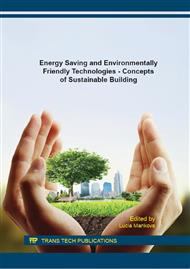[1]
NG, Lisa C., Andrew K. PERSILY a Steven J. EMMERICH. Improving infiltration modeling in commercial building energy models. In: Energy and Buildings. Elsevier: Elsevier Ltd, 2015, pp.316-323. DOI: 10. 1016/j. enbuild. 2014. 11. 078. ISSN 03787788.
DOI: 10.1016/j.enbuild.2014.11.078
Google Scholar
[3]
UVIZLOVÁ, Martina a Tereza BEČKOVSKÁ. The transition of the water steam through the composition of the diffusive closed circumferential wall of the wooden house with the proper and improper realization of vapor barrier. In: ,. Envibuild buildings and environment 2013. Durnten-Zurich: Trans Tech, 2014, pp.446-449.
DOI: 10.4028/www.scientific.net/amr.899.446
Google Scholar
[4]
SAITO, Hiroaki, Hisashi MIURA a Yasuo KUWASAWA. Study on Hygrothermal Performance Related to Vapor Proofing and Air Tightness for Wooden Exterior Walls. In: Journal of Environmental Engineering (Transactions of AIJ). Japan: Architectural Institute of Japan, 2013, pp.461-470.
DOI: 10.3130/aije.78.461
Google Scholar
[6]
BEČKOVSKÝ, David, Tereza BEČKOVSKÁ, Vlach FRANTIŠEK a Vaykay FRANTIŠEK. Diffusion of water vapour, monitoring and risk analysis of wooden walls. In: Drevársky výskum: Holzforschungsbericht. Bratislava: Štátny drevársky výskumný ústav, 2014. ISSN 1336-4561.
Google Scholar
[7]
ŠKRAMLIK, Jan a Miloslav NOVOTNÝ. 18 Moisture transport within building materials. In: eds. Pedro Castro-Borges [et al]. Concrete under severe conditions: environment and loading : proceedings of the 6th International conference on concrete under severe conditions (CONSEC'10), Mérida, Yucatán, Mexico, 7-9 june 2010. Boca Raton [etc. ]: CRC Press, 2010, pp.1131-1140.
DOI: 10.1201/b10552-148
Google Scholar
[8]
ADAM, Gabriela, Ulrich PONT a Ardeshir MAHDAVI. Evaluation of Thermal Environment and Indoor Air Quality in University Libraries in Vienna. In: Envibuild buildings and environment 2013. Durnten-Zurich: Trans Tech, 2014, pp.315-320.
DOI: 10.4028/www.scientific.net/amr.899.315
Google Scholar
[2]
NOVÁK, Jiří. Vzduchotěsnost obvodových plášťů budov. 1st ed. Praha: Grada, 2008, 203 pp. Stavitel. ISBN 978-80-247-1953-5.
Google Scholar
[5]
VAVERKA, Jiří. Stavební tepelná technika a energetika budov. 1st ed. Brno: VUTIUM, 2006, 648 pp. ISBN 80-214-2910-0.
Google Scholar


